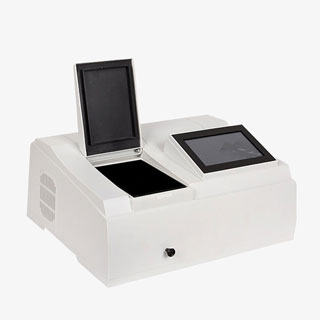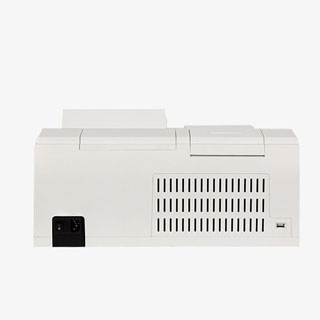UV-Visible spectrophotometer with single-beam photometric mode, wavelength range of 190-1100nm or 325-1100nm optional, automatic wavelength setting and precision automatic T/A conversion, suitable for medicine and health, clinical testing, biochemistry, petrochemical, schools.

7-inch touch screen
- Adopt a 7-inch color touch LCD display, flexible and convenient operation.
- Streamlined shape and compact size.
- Built-in thermal printer.
- Multi-purpose analyzer.

Adopt microcomputer system
- With memory storage function.
- Provide power failure protection.
- A standard printer communication port is available.
Application
The spectrophotometer is easy to operate, has perfect functions and high reliability, and can be widely used in drug testing, drug analysis, environmental testing, hygiene, and food epidemic prevention.
| Model | SISCO-N4S | SISCO-N4 | SISCO-N2S | SISCO-N2 |
| Photometry Mode | Single Beam | |||
| Monochromator Type | Czemy-Turner | |||
| Focal Length | 160mm | |||
| Grating | 1200 lines/mm | |||
| Detector | Silicon Photocell | |||
| Spectrum Bandwidth | 2nm | 4nm | ||
| Wavelength Setting | 7-inch color touch-screen | |||
| Wavelength Range | 190-1100nm | 325-1100nm | ||
| Wavelength Accuracy | ±1nm | |||
| Wavelength Repeatability | ≤0.5nm | |||
| Photometric Range | 0.0-200.0%T -0.301-4.000A 0.000-9999C |
|||
| Photometric Accuracy | ±0.3%T ±0.002Abs (0-0.5A) ±0.004Abs (0.5- A) |
±0.3%T | ||
| Photometric Repeatability | ≤0.15%T 0.001Abs (0-0.5A) 0.002Abs (0.5-1A) |
≤0.2%T | ||
| Scanning Speed | Fast-Medium-Slow | — | Fast-Medium-Slow | — |
| Baseline | ≤±0.003A (200-1090nm) | — | ≤±0.003A (335-1090nm) | — |
| Stray Light | ≤0.1%T (at 220nm Nal, 360nm NaNo2) |
≤0.1%T (at 360nm NaNo2) |
||
| Noise | 100% (T) noise ≤0.5% (T), 0% (T) noise ≤0.2%(T) | |||
| Dirfting | ±0.002 Abs/30min (at 250nm and 500nm after 2h warm up) |
±0.002 Abs/30min (at 500nm after 2h warm up) |
||
| Power | AC220V ±22V 50Hz ±1Hz, 180W | AC220V ±22V 50Hz ±1Hz, 100W | ||
| Packing Size | 540mm * 440mm * 300mm, 18kg | |||
A1: What is the difference between a UV-Visible spectrophotometer and a visible spectrophotometer?
Q1: The difference between UV-Visible spectrophotometer and visible spectrophotometer is that the measurement wavelength range is different, UV generally uses a hydrogen lamp, the measurement wavelength range is of 180 ~ 350NM, visible generally uses a tungsten lamp, and the measurement wavelength range of 320 ~ 1000NM. The so-called UV-Visible spectrophotometer also means that this instrument can change the light source, can determine the absorption peak in the UV and visible part of the compound.
A2: What is the wavelength range of the UV-Visible spectrophotometer?
Q2: Ultraviolet-visible (UV-Vis) spectrophotometers use a light source that illuminates the sample with light in the UV to visible wavelength range (typically 190 to 900 nm). UV-Vis-NIR spectrophotometers extend the wavelength range to the near-infrared (NIR) (800 to 3200 nm).
A3: What is the principle of operation of a spectrophotometer?
Q3: The basic principle of the spectrophotometer is that the substances in solution are excited by light irradiation, resulting in the effect of light absorption, the absorption of light by substances is selective, a variety of different substances have their own absorption spectrum, so when a monochromatic light through the solution, its energy will be absorbed and diminished, the degree of light energy diminution and the concentration of substances have a certain proportional relationship, that is, in line with the colorimetric principle - -Biel's law.
Tips: What is the difference between a double-beam and single-beam spectrophotometer?
A single-beam spectrophotometer has only one beam of light, while a dual-beam spectrophotometer has two beams of light.
A spectrophotometer has two beams of light, one that passes through the reference solution and one that passes through the sample.
Thank you for buying industrial test and measurement equipment on SISCO.com, all products sold by SISCO and the partner cover a 12 months warranty, effective from the date of receiving the products.
What is covered?
SISCO is responsible for providing free spare parts, and free technical support to assist the customer to repair the defective products until the problem is solved.
What is not covered?
- Product purchased from anyone other than a SISCO store or a SISCO authorized reseller.
- Expendable parts.
- Routine cleaning or normal cosmetic and mechanical wear.
- Damage from misuse, abuse or neglect.
- Damage from use of parts other than SISCO approved.
- Damage from use outside the product’s usage or storage parameters.
- Damage from use of parts not sold by SISCO.
- Damage from modification or incorporation into other products.
- Damage from repair or replacement of warranted parts by a service provider other than a SISCO authorized service provider.
- Damage caused by the application environment not meeting the product usage requirements and the failure to perform preventive maintenance.

